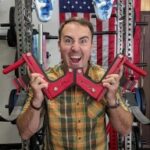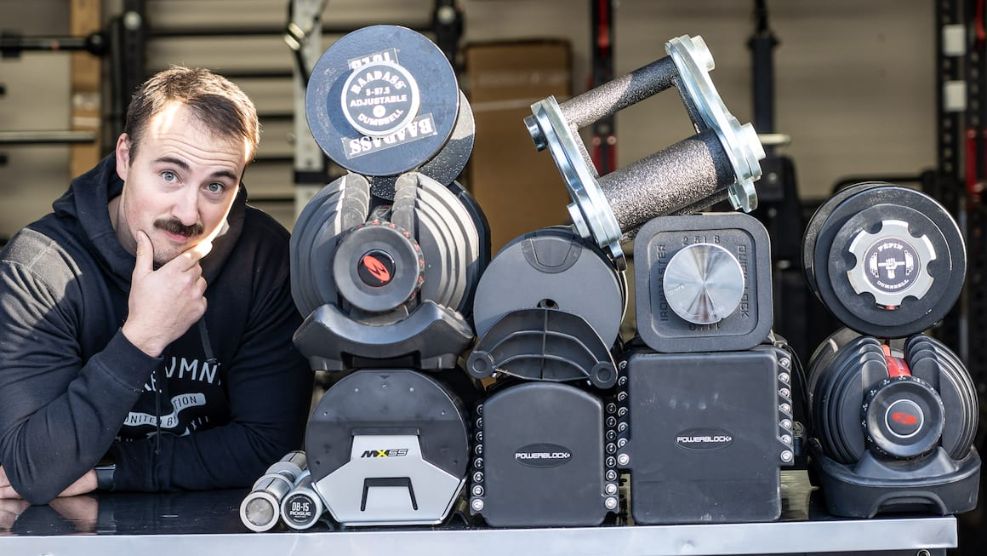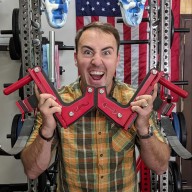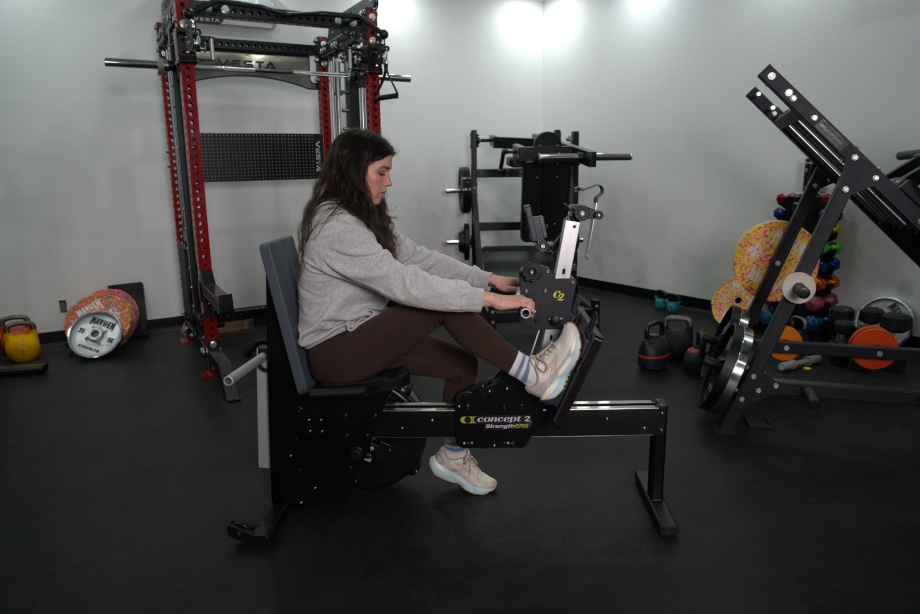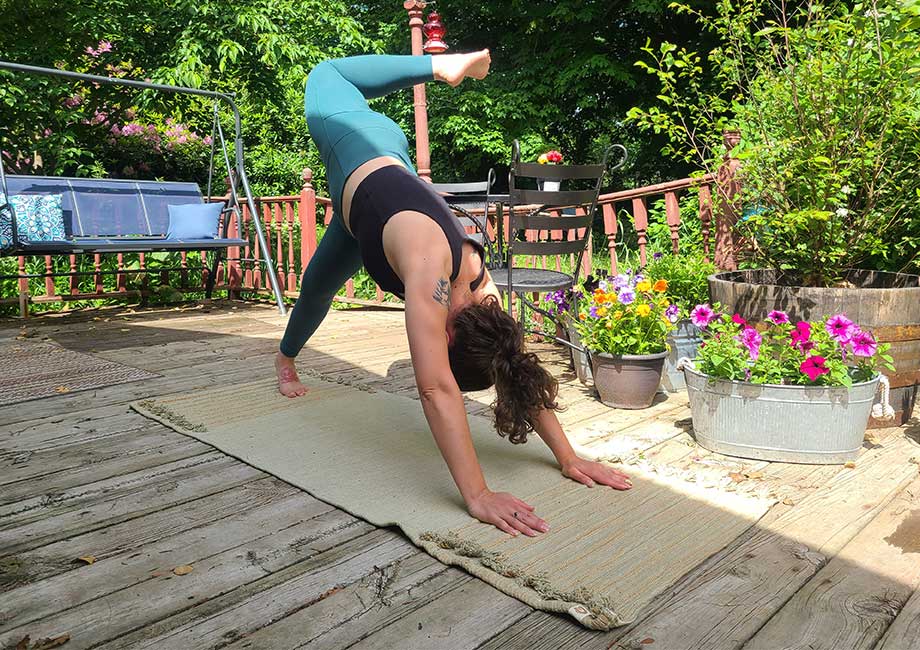Garage Gym Reviews collaborated with Jacob Penner, USA Weightlifting Level 1 Coach, NCSA Certified personal trainer, and CrossFit Level 1 Trainer to give expert advice on the best free weights workouts.
Hey everyone! Coop here from Garage Gym Reviews. With the home gym community growing, so many people want to get started but have limited equipment and a great place to start is with free weights as they are an extremely useful tool for achieving a wide variety of different workout goals.
So, I sat down with my friend and USA Weightlifting certified coach, Jacob Penner, to deep dive into how to use free weights for total body movement.
In this guide, we detail the movement patterns to structure your workouts around, which weights to buy, and because we’re two cool guys, we even included two free weight-only workouts to get you started. Let’s dive right in.
Benefits of Free Weights
Free weights are a great option for many types of people. If you’re a barbell veteran like me, you benefit from shaking up the routine and attacking the movements differently. On the other hand, if you’re new to working out or don’t have access to a full gym, you can get plenty of muscular and athletic development using free weights.
A few reasons why I like using free weights (and you will too):
- They require you to stabilize the weight as you lift it, which has added benefits not felt in typical bilateral (using both limbs or sides of the body) barbell movements, especially not on the *gasp* Smith machine.
- They tend to be more accessible for most people.
- They’re a more budget-friendly option.
How to Use Free Weights and Include Them in Your Routine
When it comes to designing workouts, Jacob believes that you should organize your exercises by movement, not muscles–this ensures that your joints are moving through their full range of motion, which develops a well-rounded and functional body.
Separating movements by muscle groups is a very old-school way of thinking. Walk into any gym and you’ll probably hear a muscles-popping bro say he is hitting “back and bi’s.” Then, he’ll do a workout full of bent over rows, chest-supported rows, and cable rows.
Sure, this lights up the lats, upper back, and biceps, and it’s good as an isolated workout in a vacuum, but can be problematic long-term if it’s the only way we train these muscle groups.
“When we perform only horizontal pushing and pulling such as bench press and rows, the shoulder achieves only about half of its full flexion and only most of its extension,” Jacob says. (Flexion is when the elbow is overhead, extension is the elbow behind the shoulder.)
“When the muscles see huge development through that range of motion without overhead work, we lose the shoulder flexion mobility. This leads to unhealthy compensation patterns when it comes time for us to put our arms overhead.”
Jacob proposes a different approach that involves six movement patterns:
- Push (horizontal and vertical)
- Pull (horizontal and vertical)
- Squat
- Hinge
- Lunge
- Carry
Generally, Jacob suggests, try to hit each of these categories for about the same amount of total reps for the week. For example, if I add up all my reps for the week and 120 of them are dedicated to horizontal pushing, I’ll want to put at least 120 reps of a similar intensity horizontal pulling movement in there to keep my body balanced.
All that being said, pre-existing strengths and weaknesses may require you to give more time to certain movement patterns. If you’re not a strong squatter and want to get better, spend 3-4 weeks increasing the squat volume in your workouts and see how your abilities and strengths start to balance out.
Now, let’s break down these movements.
How To Maximize Your Training
Setting a Goal
Setting a goal is important. Whether you are looking to build strength or gain, it’s best to decide what is it you exactly want to achieve and build a plan to achieve it.
Determine Your Weight
If your goal is to gain strength and size, it’s recommended to choose heavyweights to challenge your body. If your goal is trying to achieve more persistence, go for lighter weights.
Form
Completing exercises correctly and in the proper form is a must. If you are not making proper form and priority, you rick on the advantages of the workout and could injure yourself. Focus on practicing technique before increasing weights.
Upper Body Push
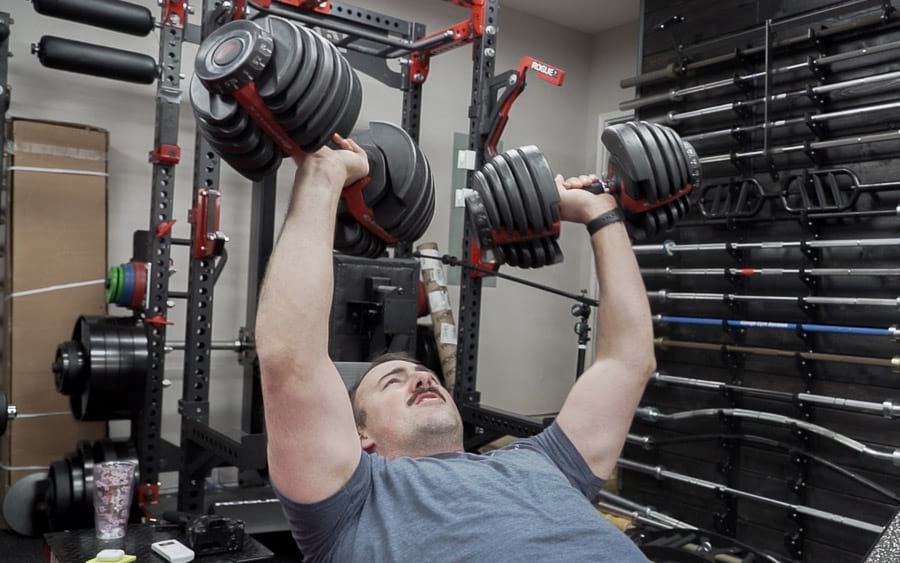
Upper body push movements can really be broken into two groups: vertical and horizontal.
Vertical push movements work your shoulders, triceps, and (even to some degree) recruit the chest and upper back muscles to stabilize your shoulder joint. These movements are the most effective when it comes to firming up the shoulders. Almost all of these movements can be performed with dumbbells:
- Strict overhead press
- Single arm overhead press
- Arnold press
- Push press
- Power jerks
RELATED: Best Back Exercises
Horizontal push movements are forward pressing movements. When you do a horizontal push, you’re still working the shoulders and triceps, but recruiting more of the chest muscles to perform the movement. And you know I love a good chest pump.
You can get a great dumbbell-only horizontal push workout with:
- Bench press variations (incline, decline and flat bench)
- Floor press
- Pec flies
- Front raises
Jacob’s Tip: For bonus points and more demand on shoulder stabilization, you can do pushes with odd objects, like stones, sandbags, and even small humans! (I lift my kids all the time.) An odd object creates instability, which forces the muscles in your shoulder that are dedicated to stability to work harder. In turn, this makes for a more balanced shoulder that is strong through a full range of motion, and less vulnerable to injury.
Upper Body Pull
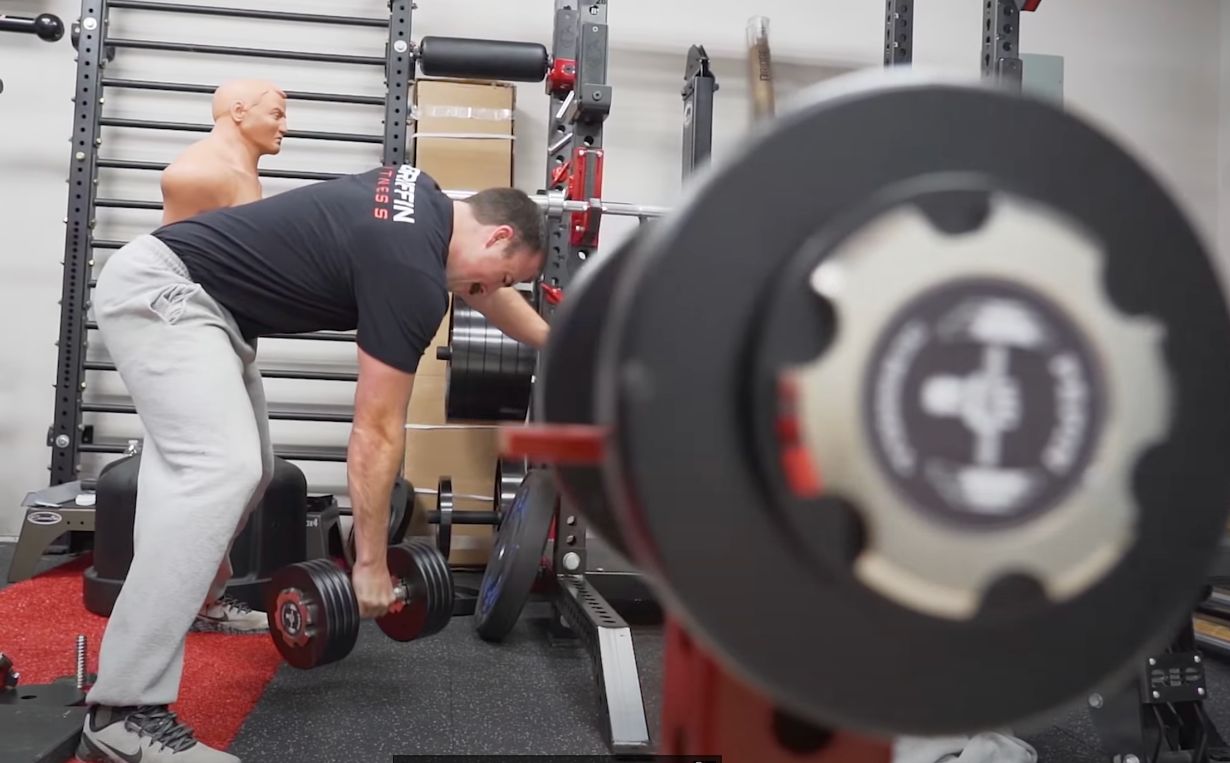
Just like our pushes, the upper body pull can be broken up into horizontal and vertical movements. It’s important that we balance our pushing-pulling ratio to keep the shoulders healthy and keep us from bad posture.
Horizontal pulls are when you take something in front of you and pull it toward you, or for bodyweight movements, in the case of bodyweight movement, you pull yourself forward. Horizontal pulls can produce some serious back and arm development, recruiting the biceps, rear delts, and back muscles such as the traps, lats, and spinal erectors.
The main horizontal pull exercise is the row. There are many different row variations from the classic barbell bent over row, to the single dumbbell row, to the bodyweight inverted row. With some creativity you can get a great horizontal pull workout on limited equipment.
RELATED: Best Dumbbell Exercises
My favorite movement is the single arm dumbbell row. This one can be tweaked in so many ways to get the targeted effect. For example, the row is going to work more of your upper back if you’re pulling the dumbbell up toward the ribcage/armpit area.
On the other side of things, there will be more lower back and lat activity if you really let the dumbbell stretch your arm down low, then pull to around belly button height.
Vertical pulls involve pulling the hand from an overhead position down to below the shoulder, placing most of the strain on the lats and biceps.
These movements are a bit limited as most vertical pulls involve equipment such as a pull-up bar or lat pulldown machine.
That being said, you can definitely get some great work with the lat in that fully stretched overhead position through the dumbbell pullover. If you have a weight bench or chair and a dumbbell, you can get your pullover game on.
Jacob’s Tip: To get more out of these pulls, try manipulating your time under tension! Incorporate tempo reps by going extra slow (I’m talking 3-4 seconds) to lower the weight back down to your stretched position.
For example, in the case of the dumbbell row, you can pull fast up to your side, hold it for a second to ensure full contraction, and slowly count to 4 as you lower the weight all the way back down. This may seem easy on the first rep or two, but toward the final reps of a set of 10, you’ll be burning!
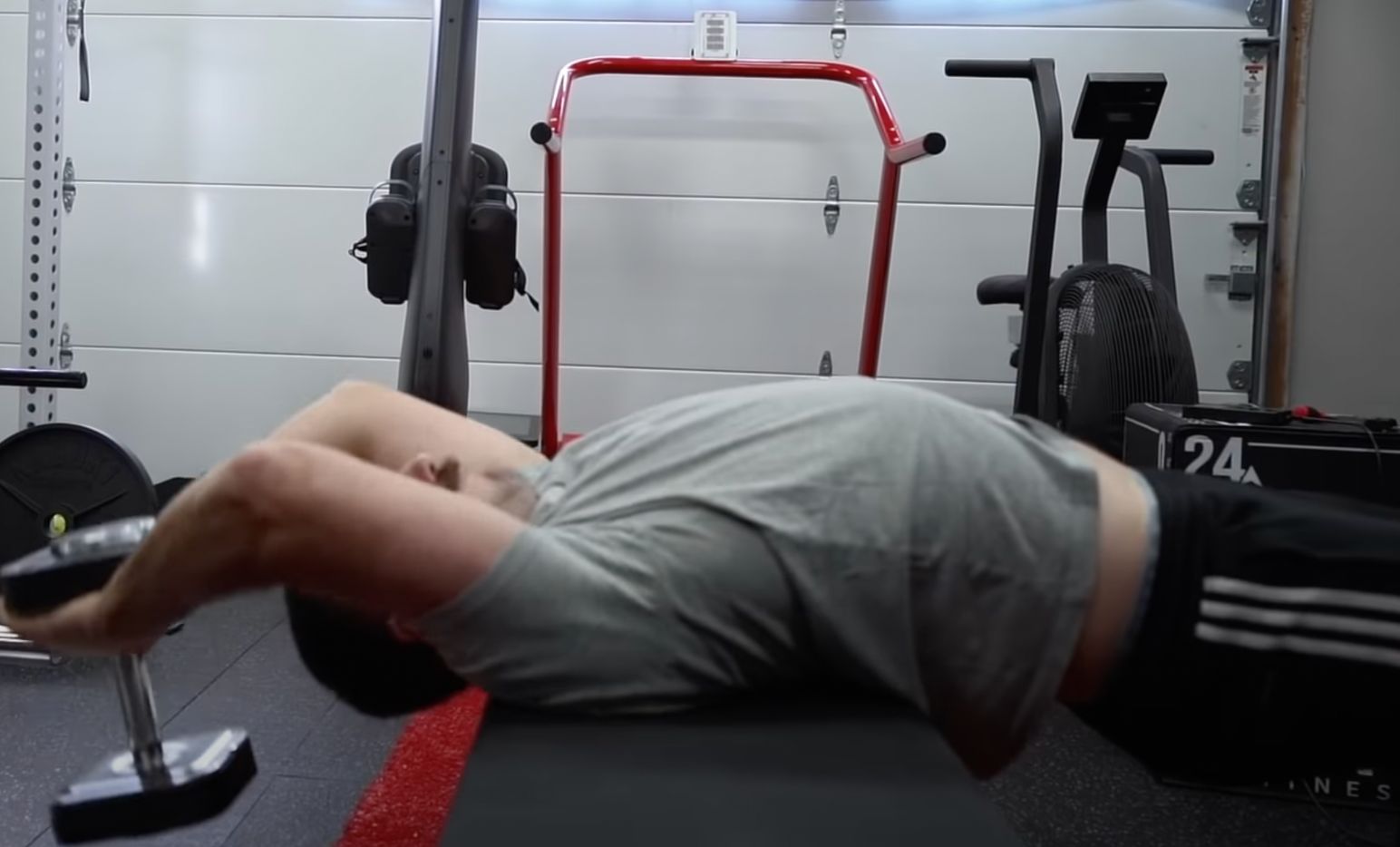
Squat
In my opinion, the full-depth squat is the most versatile movement you can do with free-weights. Full-depth means you sit as low as your body will safely allow you to, whether that’s ass-to-grass or with the hips at knee height.
The squat has plenty of moving parts and demands. There’s muscle contraction all through the quads, hips, and spinal erectors that you can definitely feel. On top of that, there’s a bracing demand through the core to keep you upright throughout the squat.
To cap it all off, a full-depth squat demands mobility all through your body.
“When I look at someone squat to full depth with their whole foot on the ground, knees tracking over the toes, and a flat back, I know I’m looking at a healthy and athletic individual,” Jacob says.
You don’t need a heavy barbell and squat rack to benefit from squatting. I like to look at equipment limitations as an opportunity to get more reps in and refine movement patterns. Sure, you aren’t able to stimulate your body the same way, but accumulating hundreds of reps of bodyweight or lightweight squats will ensure your body is consistently moving in a safe pattern.
Some of my go-to dumbbell squats include:
- Dumbbell goblet squat
- Heels elevated narrow stance squats
- Squat jumps
- Dumbbell overhead squats
- Dumbbell front squats
Jacob’s Tip: When you hold the weight in front of you, like in the goblet squat, the knees will track a little farther forward than they would on a bodyweight squat. According to Jacob, this is a good thing! This trains the quads in deeper knee flexion (bend), a very important quality for injury prevention. On top of it all, you’ll feel a pretty intense quad burn when you get into higher-rep sets, like those of 10 or more.
Hinge
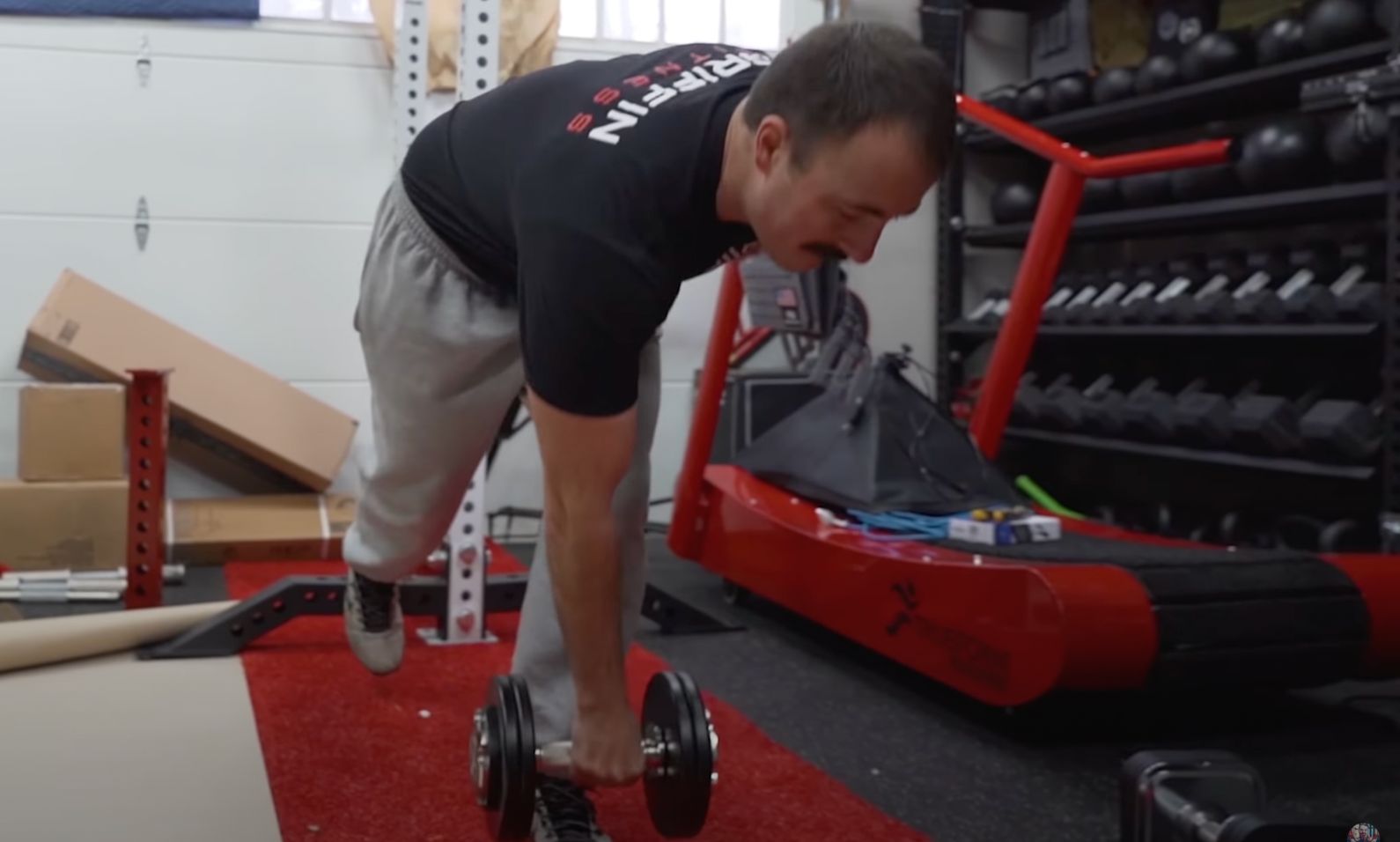
Hip hinges are incredibly important for overall health and help you develop all of the muscle groups that are located on the backside of your body. You perform a hip hinge any time your torso leans forward.
In a traditional gym setting, we see hinges with deadlifts, good mornings, romanian deadlifts, and all of their single-leg variations. In any hinge we do, we’re placing a stretch on the hamstrings and glutes.
There’s also an isometric demand on the spinal erectors, meaning they are fighting to maintain their position. This makes sure you are keeping a “flat back” in that your upper nor lower back starts to round during the movement.
Similar to how I talked about the squat, practicing hinges with light weights can be great for injury prevention and movement pattern refinement, in addition to developing the muscles.
My go-to hinge is the dumbbell single-leg Romanian deadlift. In my experience, this one places such a deep stretch on the hamstrings that it leaves me sore for days. But that’s not everything. The single-leg RDL has a huge demand for balance from the foot and lower leg, our base of support for all movements!
To put it simply, this is incredibly applicable to daily life. How often do you lean over to pick something up with your weight shifted more toward one foot than the other? Why wouldn’t you want to have the muscles and coordination to be better at daily tasks?
Jacob’s Tip: Having trouble with balancing on single leg movements? Try taking your shoes off and actively squeezing your big toe into the ground. This will help you root your feet into the ground for a more secure base.
Lunge
The lunge category involves any kind of asymmetrical foot stance accompanied by a lowering of the hips. An asymmetrical stance simply means that your feet are not across from each other; one is forward, one is back.
Lunge movements include:
- Split squats
- Forward lunges
- Reverse lunges
- Side lunges
- Walking lunges
“The lunge is vital because it hits your legs and hips from all different angles,” Jacob says. “Lunges provide resistance through multiple planes, rather than the straight up and down Sagittal plane that most of our lifts will move through.”
Jacob’s Tip: My personal favorite and most versatile movement in lunges are the split squat and all its variants. The possibilities are endless. Elevate the front foot to get more stretch on the front glute. Elevate the back foot to place more of the load on the front leg. Hold dumbbells at your sides to add a grip component to the movement. Hold the dumbbells over your head for a tough mobility challenge.
Carry

This category is where Jacob puts any carrying movements that place a high demand on stabilizing your core muscles core. My top three movements here are:
- Farmer carry
- Overhead carry
- Bottom-up dumbbell or kettlebell overhead carry
The farmer’s carry is a tried and true movement for grip strength and maintaining good posture. You know how you try to carry all the grocery bags into the house in one trip, and your hands start to hurt as they clutch the bag handles? Solution: Farmer’s carries.
Overhead carries, on the other hand, can be tricky! You may feel like you’re stable overhead from doing presses, but having to hold that lockout for an extended period of time can expose weaknesses in your position. For example, if you have trouble keeping the weights directly above your head and you have to arch your back to keep them from falling forward, you probably have tight lats and underactive traps.
Jacob’s Tip: The bottom-up dumbbell vs kettlebell overhead carry is my absolute favorite for all of the above benefits. It trains your grip as you try to keep the dumbbell or kettlebell from tipping over while also demanding a perfectly straight arm. Since holding the bell is such a balancing act, the arm will have to stay completely vertical. There are very few ways to compensate for improper movement with the bottom-up overhead carry.
Get Your Workout On
Jacob, who has taken youth, senior and masters athletes to national-level weightlifting competitions, wrote two full-body free weight workouts incorporating the push, pull, squat, hinge, lunge and carry. (You can use dumbbells or kettlebells for these!)
Workout 1
3 Sets – Giant Set A:
A1) 8ea side Alternating DB Strict Press
A2) 8-12 DB Pullover
A3) 10ea Single Leg DB RDL
3 Sets – Giant Set B:
B1) 10ea Single DB Row w/ 3s Eccentric
B2) 10 DB Floor Press w/ 3s Eccentric
B3) 10 DB Reverse Fly
4 Sets – Giant Set C:
C1) 15-20 Heels Elevated Narrow Stance Goblet Squat
C2) 10ea Bodyweight Split Squat
Finisher:
Accumulate 100 yards on each arm of a Single KB Bottom-up Overhead Carry
Workout 2
2 Sets – Giant Set A:
A1) 30 steps DB Walking Lunge
A2) 15 DB Clean + Strict Press
A3) 15 DB RDL
A4) 15 DB Front Squat
2 Sets – Giant Set B:
B1) 100ft Overhead Carry
B2) 15-20 KB Swing
B3) 15-20 lightweight Squat Jumps
B4) BURNOUT Push-ups
Finisher:
50 DB Lateral Raises – every time you have to give your shoulders a rest, perform 10 Sit-ups then get back to Lateral Raises.

Coop’s Free Weight Recommendations
Choosing free weights can be overwhelming with such a variety of options. Maybe you have the space and funds and can get a full set of fixed dumbbells and kettlebells. Or on the other hand, you have limited space and need to go the adjustable route. In either case, I’ve got you covered:
Powerblock Elite Series Adjustable Dumbbells
These are my top pick when it comes to adjustable dumbbells. I have enjoyed using Powerblocks for almost 10 years, ever since I started my first garage gym. They are easily adjustable in 2.5- and 5-lb increments, going up to 90 lbs with add-ons. These things are sturdy as can be, even stacking up well against fixed dumbbells.
For more on these, check out my Powerblock Elite Series review.
Bowflex SelectTech 552 Adjustable Dumbbells
Looking to save some cash? Budget home gym equipment is key. The Bowflex SelectTech 552 Adjustable Dumbbells are my budget pick for adjustable dumbbells. The Bowflex dumbbells are extremely affordable at $329 for a pair adjustable up to 52.5 lbs. The SelectTech dials on the side make it easy and efficient to change the weights at a flick of the wrist. My only drawback with these is that they are not the most durable. You’ll have to be careful, making sure to place these down gently.
For more options, see my full roundup of the best adjustable dumbbells.
Rep Fitness Rubber Coated Hex Dumbbells
The Rep Fitness Rubber Coated Hex Dumbbells are priced a bit cheaper than their competitors, but they are constructed in a way that I personally prefer more. They have a straight, 100% knurled handle, rather than the typical tapered and partially-knurled handle you see on most hex dumbbells. Their construction also has a completely fixed rubber head, setting them apart from competitors’ constructions that often come loose.
Rogue E-Coat Kettlebells
I believe the Rogue E-Coat Kettlebells are one of the best kettlebells on the market for most people. The coating is superior to the typical powder coat in both durability and overall feel. They are priced competitively but are some of the highest quality bells I’ve used after testing almost every kettlebell there is in the past 5 years.
Final Takeaway
At the end of the day, no machine or barbell is going to fully replicate the benefits we reap from working out with free weights. There are drawbacks, especially that typical dumbbell weights aren’t going to give seasoned lifters a “heavy” stimulus as a max squat would. That being said, if you want to improve your overall body composition and athleticism, free weights are absolutely a great option.
Free Weight Workout FAQs
Can you build muscle with just free weights?
Free weight workouts stimulate more muscle mass than machine exercises, making them more effective for long-term muscular growth. To achieve the greatest results, focus on free weights for the majority of your workouts and employ machines to help you strengthen resistant muscles.
What are 3 types of free weights?
Dumbbells and kettlebells are the most common free weights in the gym, but medicine balls, sandbags, and even barbells are free weights.
What is the difference between free weights and weight training?
Weight machines, in general, are an excellent tool for beginners since they teach appropriate forms and limit the danger of damage. The use of free weights, on the other hand, allows you to train more muscles and improve your functional fitness.
What workouts can you do with free weights?
Seated bicep curls, hip thrust, shoulder press, single arm row, arnold press, push press, lunges, squats, and much more!
Is free weight training effective?
For sure! Free weight training is a sort of strength training that uses your body weight as tension.

